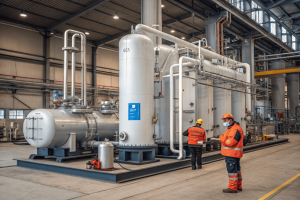Where is a CO2 detector required?
•
Where is a CO2 detector required?
You’re planning to install a CO₂ recovery system or use bulk CO₂. But what about safety? You need to protect your staff from the risks of an invisible, odorless gas leak.
A CO₂ detector is required in any enclosed or confined space where carbon dioxide is stored or used in significant quantities. This includes walk-in coolers, breweries, beverage dispensing areas, grow rooms, and near cryogenic CO₂ storage tanks to prevent asphyxiation.
Whenever I start a new project with a client, one of the first topics we discuss is safety. It's easy to focus on the efficiency and cost savings of recovering CO₂, but we can never forget that we are concentrating and storing a gas that displaces oxygen. A CO₂ detector isn't just a compliance item to check off a list; it's a critical life-safety device. Before we dive into the specifics, it's crucial to understand a common point of confusion: Carbon Dioxide (CO₂) is not Carbon Monoxide (CO). A CO detector will not protect you from a CO₂ leak, and vice versa. They are different gases with different dangers.
What are carbon dioxide detectors used for?
You see a detector on the wall, but what does it really do? It’s more than just a box that might beep one day. You need to understand its fundamental purpose in your facility.
A carbon dioxide detector is a life-safety device used to continuously measure the concentration of CO₂ gas in the air. It provides an early warning by sounding an alarm when levels exceed safe thresholds, protecting personnel from the risk of asphyxiation.
I always emphasize to my clients that a detector’s main job is to make the invisible visible. Humans cannot sense a dangerous buildup of CO₂. The gas is colorless, odorless, and doesn't cause irritation at initial high concentrations. The detector acts as a constant, vigilant set of electronic senses, watching over your team. Without it, the first sign of a major leak could be someone losing consciousness, and by then, it is far too late.
Protection and Prevention
The detector serves two primary functions: personnel safety and regulatory compliance. It's not just about a final, loud alarm; it's about providing tiered alerts that allow for corrective action before a situation becomes critical. Most modern detectors have multiple alarm setpoints.
- Low-Level Alarm (Warning): The first alarm is typically set around the Time-Weighted Average (TWA) occupational exposure limit (5,000 ppm according to OSHA). This alarm alerts staff that there is a minor leak or poor ventilation that needs to be addressed. It's a signal to investigate, not to evacuate.
- High-Level Alarm (Danger): The second alarm is set at a much higher level, often around the Short-Term Exposure Limit (STEL) of 30,000 ppm. This indicates a serious leak and a dangerous environment. This alarm means immediate evacuation of the area is necessary.
By monitoring the levels continuously, the device ensures your facility remains compliant with workplace safety standards like those from OSHA. It provides the data and the warnings necessary to maintain a safe working environment where a potentially hazardous gas is being used.
What would set off a CO2 detector?
You have a detector installed, but you are wondering what could actually trigger it. Is a tiny leak enough, or does it take a major equipment failure to sound the alarm?
A CO₂ detector is set off when the concentration of CO₂ gas in the air around its sensor exceeds a pre-set threshold. This is almost always caused by a gas leak from equipment, poor ventilation, or the accumulation of CO₂ in a low-lying, confined space.

I was at a client's brewery once when a low-level alarm went off. There was no panic, just a clear signal that something wasn't right. It turned out to be a very minor leak from a loose fitting on a carbonation stone hose—not a catastrophe, but a problem that needed fixing. The detector did its job perfectly. It identified a small, wasteful, and potentially escalating issue before it became a real danger. The triggers are not always dramatic explosions; often, they are small, correctable faults.
Common Triggers and Causes
The alarm on your CO₂ detector is not a sign of failure; it's a sign that the system is working as intended. Understanding the potential causes helps you respond appropriately.
| Cause of Alarm | Description | Example Scenario |
|---|---|---|
| Equipment Leaks | This is the most common cause. Gaskets, seals, pipe fittings, valves, or hoses can fail or loosen over time. | A worn-out seal on a CO₂ storage tank valve begins to seep gas into the room. |
| Poor Ventilation | CO₂ produced by normal processes (like fermentation) accumulates because the HVAC system is not working effectively. | An exhaust fan in a grow room fails, allowing CO₂ from enrichment to build up overnight. |
| Gas Pooling | CO₂ is heavier than air. In rooms with poor air circulation, like cellars or walk-in coolers, a small leak can create a dangerous pocket of gas near the floor. | A slow leak from a soda fountain system fills the bottom of a basement cooler. |
| Accidental Discharge | A valve is accidentally left open, or a safety relief valve on a tank is triggered due to over-pressurization. | An employee accidentally knocks open a valve while moving kegs, releasing a cloud of CO₂. |
In almost every case, a CO₂ alarm is a call to action: ventilate the area, find the source of the gas, and fix the problem.
Where should you put your carbon dioxide detector?
You've purchased a detector, but now you have to decide on the best spot to install it. Placing it in the wrong location could make it completely ineffective during a real emergency.
Place your CO₂ detector in any room where CO₂ is stored or used. Install it low to the ground, typically 12-18 inches (30-45 cm) from the floor, because CO₂ gas is 1.5 times heavier than air and will accumulate in low-lying areas first.

This is one of the most critical and most frequently misunderstood aspects of CO₂ safety. People are used to smoke detectors, which are placed on the ceiling because smoke rises. You must fight this instinct when installing a CO₂ detector. I was auditing a facility and found their new detector installed five feet up the wall, right at eye level. It looked good, but it was useless. A person could have been unconscious on the floor in a pool of CO₂ before that detector ever triggered. Placement is everything.
Rules for Proper Installation
Following a few simple rules ensures your detector will do its job when you need it most. These guidelines are based on the physical properties of the gas and a common-sense approach to safety.
- Install it Low: As mentioned, 12-18 inches (30-45 cm) from the floor is the golden rule. This ensures the sensor is in the "breathing zone" of someone who may have fallen and is in the area where the gas will concentrate first.
- Place it Near the Source: Position the detector within 10 feet of the potential leak source, such as the CO₂ storage tank, gas cylinders, or the main connection points for your carbonation system.
- Avoid Obstructions: Do not install the detector behind furniture, equipment, or curtains. The sensor needs unobstructed airflow to get an accurate reading of the room's ambient air.
- Consider Airflow: Keep the detector away from doors, windows, and high-flow ventilation fans. Strong drafts can dilute the gas concentration around the sensor, giving a false sense of security and delaying an alarm.
- Use Multiple Detectors: In large or oddly shaped rooms, one detector may not be enough. You may need multiple units to adequately cover the entire space, especially if there are multiple potential leak sources.
Conclusion
CO₂ detectors are required in any enclosed space where the gas is used or stored. They are critical life-safety devices that must be installed low to the ground to be effective.
You may also be interested in:

Why is CO₂ recovery technology gaining popularity worldwide?
Why is CO₂ recovery technology gaining popularity worldwide? You see headlines about carbon capture everywhere. But you wonder if it's
Read more
How is a CO₂ recovery system designed to fit different industries?
How is a CO₂ recovery system designed to fit different industries? You're under pressure to implement a CO₂ recovery solution.
Read more
How energy-efficient are today’s CO₂ recovery technologies?
How energy-efficient are today’s CO₂ recovery technologies? You want to recover CO₂, but you fear that high electricity bills will
Read more